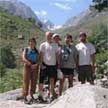Dan and Betty Churchill Exploration Fund
Graduate Students
Arzhan Surazakov and Dan Joswiak, UIdaho
Susan Kaspari and Bjorn Grigholm, UMaine
July 16, to August 6, 2005

Susan Writes
Dushanbe, Tajikistan
We've returned a day early from our acclimatization trip because our helicopter flight has been moved up one day, so we will fly by helicopter to Moskvina Base Camp at 4200 m tomorrow.
We had a fantastic time on our acclimatization trip. We drove 1.5 hours north of Dushanbe, driving along a huge beautiful river. Along the way under the trees there are platforms set up with beautiful cloth covers and cushions. Locals enjoy the shade, try and escape the heat, drink tea, and relax. We were dropped off at the entrance to a valley, and hiked 5km along a huge roaring junction with another river and stopped for lunch. On one side of the river a group of Tajik sheepherders live, and on the other is a weather station from Soviet Union times. Our cook, Vicki, is friends with the man who lives at and runs the met station. His name is Ivan, and he invited us to cook at his home and spend the night. It was a magnificent place- the small house is nestled in the valley with a stream running by, there are pools to jump in, bee hives, a garden, and beautiful stone work and wood carvings everywhere. We enjoyed a yummy late lunch by Vicki, and then went hiking for another 3 hours up the valley, and returned shortly after dark. Bjorn and I slept outside, sleeping soundly after escaping the heat of Dushanbe. This morning we had breakfast, tea and talked more with Ivan and his family about the area. The met station where he lives has the highest maximum precipitation recorded in this region of Asia - 200cm of water equivalent (that's over 6 feet of water)! The majority of the precipitation comes from westerlies in the winter time. Ivan said that many of the glaciers are retreating, corroborating what others in Dushanbe have said. One of the reasons we are flying in to Moskvina Base Camp is that many of the roads are damaged from high glacial runoff. When we left Ivan's house, we crossed the huge river in a cart that runs on cables stretched high above the river- we all loved that part! We hiked back down to the road, met our driver, and returned to Dushanbe to prepare for tomorrow's flight to Moskvina.
This afternoon Vicki and Arzhan shopped for food for the next two weeks, we did some paperwork to clear us for entrance to the Pamir mountains because it is a restricted area, and had a good dinner. We are all excited to get to the mountains. We will spend approximately four days at Moskvina Base Camp acclimatizing. Moskvina is near Samoni peak, which is 7455m tall. We will then fly to the head of Fedchenko glacier at 5500m where we will stay for a week doing research. Our objective include instalingl the meteorological station to measure temperature, wind speed and direction, and pressure; drill ice cores, and do other snow studies.






